What a loaded question. The answer varies greatly depending on whom you ask. It also varies, depending on what OEMs (original equipment manufacturers) the question might be referring to. If the question was more specific such as, “are timing chains still causing headaches on certain engines? Ford™ engines? GM™ engines? BMW™? Audi™?,” the answer might be more specific, citing known issues, TSBs or recalls, on makes, models, certain engine designs and certain timing chain and gear designs.
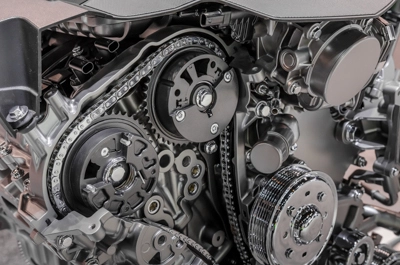
The first time I saw the gear design that used nylon teeth timing gear I had a bit of a headache trying to understand the thought process behind that idea. How long could plastic gears possibly hold up? The answer turned out to be not very long. The nylon design reduced longevity, not noise.
Personally, timing chains have caused me headaches over my entire career. It started in the mid-70s at the vocational school where I was studying auto mechanics. Larry, a friend of mine, owned a ‘57 Chevy Bel Air, which had come standard with a 283 CID engine. He had managed to get his hands on a 327 CID engine, which GM™ released in 1962 to take on Ford’s 289 CID. The 327 had quickly earned the nickname “Mighty Mouse” for its small block power.
In those days, I was considered to be the resident mechanic within my circle of friends. I had my own tools and could work on cars during my auto mechanic classes. Larry wanted to put a performance camshaft in the already powerful engine before installing it in the ‘57. Gas was 50 cents a gallon at that time. Fuel economy was not a consideration, while speed and power was.
I learned a valuable lesson after installing a cam, a new timing chain and fresh valve job on the heads.
Lesson learned, take extra care when lining up the timing marks as shown in the illustration below. Close is not good enough when setting up valve timing. The marks have to line up exactly as shown with the correct cylinder being on top dead center.
Even though I was a novice mechanic at that time, I knew that backfiring through the carburetor could not be good. Therefore, after a second tear down I got it right.
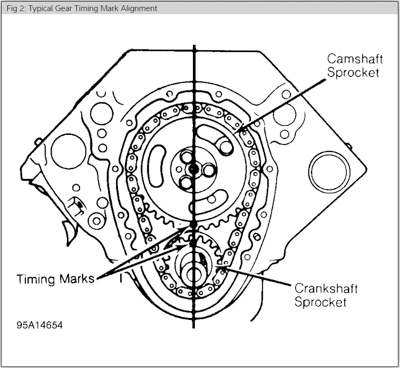
What makes the timing chain design possible is the type of chain – a roller chain. Unbelievably the roller chain has a very interesting history.
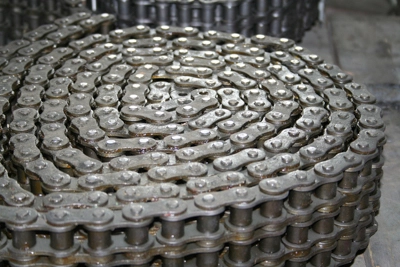
The earliest recorded mention of chain was 2200 years ago in 225 BC by Philo of Byzantium, who was a Greek engineer who wrote about mechanics. This Greek engineer was also known as Philo Mechanicus.
Philo described the first ever use of a chain drive. This chain drive was fitted within a repeating crossbow. This crossbow featured two flat-linked chains, which are connected to a windlass. This mechanism would wind back and forth to automatically fire arrows repeatedly.
In the early 1500s, Leonardo da Vinci created sketches that appear to show the first ever, steel chain concept. This chain consisted of plates and pins.
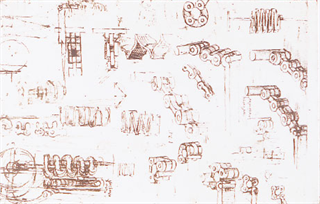
Leonardo Da Vinci Roller Chain Sketch {{PD-US-unpublished}}
What about modern timing chains? Do timing chains cause headaches? Yes, they certainly do.
My whole life I have heard, and used, the term timing chain stretch. Is it even possible to stretch a steel chain? Maybe if an intense level of heat similar to that produced from a blacksmith’s forge was applied. That would be 4000-degree Fahrenheit/2200 degree Celsius. No, timing chain stretch is not the stretching of the timing chain steel. It is an elongation of the timing chain caused by wear to the chain's components.
The most common cause of timing chain elongation is lack of maintenance, regular oil changes and the wrong oil.
Common OEMs that are known for timing chain elongation is Ford™, General/Vauxhall Motors™, Nissan™ and others. These OEMs have stated that the lack of oil changes and use of the wrong oil causes timing chain elongations.
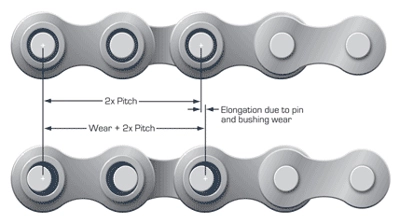
Note that the plate holes where the pins go are warn out on the second row.
Wait a minute. The OEMs have been making oil change intervals longer and longer. True, but some are dialing back the claim of “driving longer between oil changes.”
General/Vauxhall Motors
On 2007-2012 models, the oil change interval could range from 4,000 to 12,000-miles. For 2013-current models, GM has limited the interval to 7,500 miles.
In fact, there is a TSB, see below, to reprogram the ECM to reset the oil change monitor to not exceed 7,500 miles due to early failure of the timing chain as explained in the bulletin.



Therefore, oil change interval is critical to timing chain longevity. What about the type of oil? Does that matter? Below are oil type specifications from quick look ups, for the exact year, make and model vehicle. The only difference is the engine size. Note the different fluid spec for each. Could that be a common mistake? Would chain elongation be the result? Absolutely.
Lesson learned. Quick look ups make it easy and fast to ensure the right amount and oil type.


As timing chain elongation takes place, it will change camshaft and crankshaft timing. The camshaft and crankshaft position sensors sense the change. This typically will cause codes that indicate the correlation problem with the position sensors.
Timing Chain Symptoms
1. Check engine
2. Hard Start
3. No start
4. Noise
5. Engine misfire
6. Low power/poor acceleration
Click Here To View Our Case Study Using A TRITON-D10TM